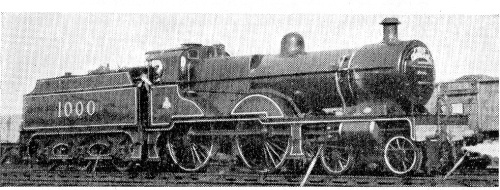Steam Locomotives of a More Leisurely Era
1902 – 4-4-0 Compounds
Midland Railway
To meet the need for increased locomotive power at the beginning of the twentieth century Johnson had, in 1900, produced his large Belpaire 4-4-0, but at the same time he was also considering a still larger engine based on the compound principle.
Amongst the various experiments in compounding which had been taking place on the railways, he was particularly impressed with an engine on the North Eastern, which had been rebuilt with three cylinders, one high pressure inside and two low pressure outside, to the patented design of William Smith, locomotive draughtsman of the NER. The main principle of this system was that the engine could at the will of the driver be worked if desired as a 3-cylinder simple, to give maximum, power on starting, and by means of controlled valves going over to the semi-compound or full compound expansion. Johnson therefore put in hand an engine of his own embodying this system which duly appeared in January 1902 as No. 2631. Four more were built before his retirement in 1903, Nos. 2632-5.
These five engines put up some fine work on the mountainous Settle-Carlisle line, and Deeley, who had succeeded Johnson, decided to build more engines of the same general design but with important differences, the chief of which was the provision of a patent regulator by which the engine always started non-compound and automatically changed over to full compound with the advance of the regulator. There were also some external differences in appearance, the running plates being raised clear of the coupling rods, whilst the rectangular rear splasher gave way to a quarter-circle blended into the cab side sheets.
Thirty of the new Deeley engines appeared in 1905-6, numbered 1000-29. At the 1907 renumbering the original five Johnson engines took the numbers 1000-4, and the Deeley engines were increased by five, becoming 1005-34. A further ten engines, Nos. 1035-44, came out in 1908-9.
No more were built in Midland days, but the design with slight modifications was adopted as a standard type early in the grouping, and no less than 195 further engines were turned out between 1924 and 1932, numbered 1045-1199, and 900-39. Still more were to have been constructed, but the order was cancelled when W.A (later Sir William) Stanier came on the scene, as he had very different ideas on the subject of locomotive power.
Nos. 1000-4 were eventually rebuilt in line with the Deeley engines, and at the same time were superheated, Nos. 1000 and 1004 in 1914, 1001 and 1003 in 1915, and 1002 in 1919. No. 1040 had already received a superheater in 1913, but it was not until 1919 that it was decided to superheat the remainder of the class, commencing with No. 1009. The LMS-built engines were, of course, superheated from the start.
The class as a whole did magnificent work; possibly their greatest achievements were on the Caledonian and G&SWR main lines in the intermediate post-grouping years. They also did remarkably well on the LNWR two-hour expresses, but were probably not quite so happy on the other LNWR main lines owing to an instinctive distrust of Compounds by North Western men inherited from the Webb days. No. 1054 made history by running non-stop from Euston to Edinburgh, a distance of all but 400 miles in May 1928. This was the quiet answer of the LMS to the LNER’s announcement that it would run the ‘Flying Scotsman’ non-stop between the two capital cities by use of a corridor tender whereby the crew could be relieved en route. The LMS reply was to divide the Royal Scot into two portions, one running non-stop to Glasgow and the other to Edinburgh. The performance was not repeated, but it effectively stole the limelight from the LNER performance.
With the decline in maintenance standards which set in during the war and has remained since, the Compounds gradually fell into some disrepute, as they required more attention in this respect than they received. Moreover, they were largely put to work on local trains, duties for which they were unsuitable, and in consequence got a poor reputation through no fault of their own, as they were magnificent engines when kept in proper trim and well handled. Probably they were the only outstanding successful compound design this country has seen.
The beginning of the end was inevitable. All passed into BR hands at Nationalisation in 1948. No.1002 was scraped shortly afterwards in the same year, and all of the Midland ones had been withdrawn by 1952. A start was made on the LMS batch in 1953, and by the end of 1959 less than a dozen remained. All except a few of the early MR engines lasted long enough to have 40000 added to their numbers.
The original No.41000 was fortunately kept in store at Crewe for a number of years and in 1959 was fully restored to its rebuilt 1914 condition in Midland colours for preservation and for working special trains.
Nos. 1000-4 as built – Driving wheels – 7’ 0”, Cylinders – 1 HP 19”x 26”, 2 LP 21”x 26”, Pressure – 200 lb., Tractive effort – 21840 lb., Weight – 59½ tons, MR & LMS classification – NA, BR classification – NA
Deeley 1905 design – Driving wheels – 7’ 0”, Cylinders – 1 HP 19”x 26”, 2 LP 21”x 26”, Pressure – 200 lb (originally 220 lb.)., Tractive effort – 21840 lb., Weight – 59¾ tons, MR & LMS classification – 4, BR classification – 4P
LMS 1924 design – Driving wheels – 6’ 9”, Cylinders – 1 HP 19”x 26”, 2 LP 21”x 26”, Pressure – 200 lb., Tractive effort – 22649 lb., Weight – 61¾ tons, MR & LMS classification – 4, BR classification – 4P






